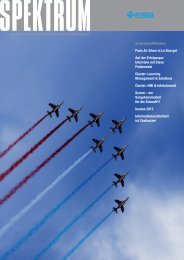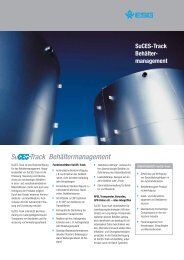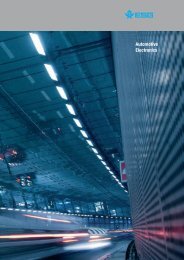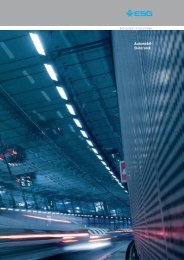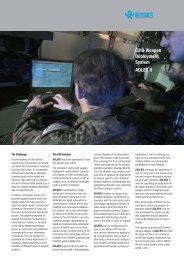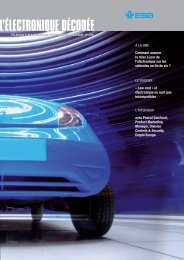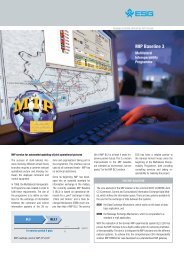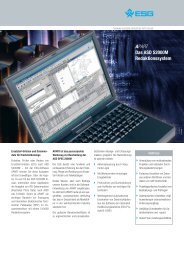Spektrum 01-06.indd - ESG
Spektrum 01-06.indd - ESG
Spektrum 01-06.indd - ESG
Erfolgreiche ePaper selbst erstellen
Machen Sie aus Ihren PDF Publikationen ein blätterbares Flipbook mit unserer einzigartigen Google optimierten e-Paper Software.
E N G L I S H S U M M A R Y<br />
The flying laboratory<br />
What is nearly 18 metres long, approximately<br />
4.5 metres high and has a rotor<br />
diameter of more than 14 metres?<br />
An average, every-day helicopter?<br />
Wrong! The flying object, which lifted<br />
off for the first time at the beginning of<br />
2006, is an aircraft which makes the<br />
hearts of development engineers beat<br />
faster. The mission equipment carrier<br />
(MAT) is not just a helicopter after all,<br />
but a flying laboratory.<br />
With the MAT, the Bundeswehr and<br />
industry have met a goal they have<br />
striven toward for a long time: the ability<br />
to test all sorts of mission equipment<br />
under real conditions – without<br />
the parts having to be licensed for<br />
flight operation. With this, tests can<br />
be carried out during the system development<br />
stage. <strong>ESG</strong> developed the<br />
entire avionics of the MAT, as well as<br />
the measuring equipment. Thereby,<br />
two equipment racks were attached to<br />
the nose, to which, for example, sensors<br />
can be fixed, weighing up to 140<br />
kilogrammes.<br />
But what makes a UH-1D a MAT?<br />
One major aspect is the separation<br />
of the helicopter from the test equipment.<br />
Two of each of most of the avionic<br />
components are on board. As a<br />
matter of principle, two pilots sit in<br />
the MAT. The test pilot flies the helicopter<br />
and tests the test equipment.<br />
The responsible aircraft pilot sits next<br />
to him. He acts as a co-pilot, who can<br />
intervene at any time and can fly the<br />
helicopter safely. In the rear area of<br />
the UH-1D, there are two workplaces<br />
for flight test engineers. They can carry<br />
out tests which would be too much<br />
to expect from the pilots, due to their<br />
complexity.<br />
The holder of the mission equipment<br />
carrier is the armaments technology<br />
service department no. 61 in<br />
Manching. The utilisation of the MAT<br />
is coordinated by <strong>ESG</strong>. Starting in<br />
June 2006, it will also be available to<br />
industry.<br />
“State of the art” as the<br />
standard for safety<br />
The clock is ticking! In less than two<br />
years, all employers in Germany must<br />
have completely implemented the industrial<br />
safety regulations. All existing<br />
and newly bought tools, devices, machines<br />
and systems which fall under<br />
the regulations must undergo a risk<br />
analysis regarding risks which could<br />
affect the employees. Different than<br />
before, the employer will also be obligated<br />
to include interaction with other<br />
work equipment and substances, as<br />
well as the environment, in future risk<br />
assessments.<br />
<strong>ESG</strong> has developed a tool with<br />
which the regulations can be implemented<br />
economically and efficiently.<br />
With OSIMA, risks can be systematically<br />
assessed and protective measures<br />
taken. It is already being put to<br />
use by the Bundeswehr. The name<br />
OSIMA stands for Object Safety Information<br />
Management Assessment.<br />
OSIMA offers a multitude of functions,<br />
e.g. a database for hazardous<br />
substances and a training module. A<br />
complete risk assessment with OSIMA<br />
makes work safer and satisfies the<br />
legal requirements. And, by the way,<br />
when unnecessary burdens are eliminated<br />
and work accidents are avoided,<br />
that means real money in the pocket<br />
of every employer. A comprehensive<br />
risk assessment saves direct and indirect<br />
accident costs and offers legal<br />
certainty.<br />
Company goals control<br />
learning concepts<br />
“... Thank you very much for buying<br />
your car from us and have a lot of fun<br />
with your new vehicle!“ Or something<br />
to that effect should be the way to say<br />
good-bye to a customer at an automobile<br />
dealership. The fact that it isn’t<br />
always so easy to be so successful is<br />
demonstrated by the benchmarks of<br />
the individual makes and automobile<br />
dealerships. Why is one salesman better<br />
than another? Often, the answer is<br />
simply: Because he was better taught<br />
in training sessions how to do his job<br />
right.<br />
The focus of such training concepts<br />
is usually to communicate<br />
the knowledge of a new product or<br />
about a process – usually independent<br />
of the respective company goals,<br />
however. All employees are trained uniformly,<br />
based on a long-term training<br />
schedule. The motto: Every employee<br />
should go through approximately the<br />
same number of training sessions.<br />
<strong>ESG</strong> has deliberately taken a new,<br />
multi-dimensional path for the past<br />
several years. The company goals of<br />
the customer, such as price stability,<br />
market growth or market share, have<br />
the highest priority here. All training<br />
activities are oriented toward these<br />
goals. <strong>ESG</strong> has proven successful<br />
in the conception and realisation of<br />
training sessions based on just these<br />
company goals, and they develop an<br />
optimal training schedule.<br />
The customer employees are no<br />
longer trained according to the “watering<br />
can principle”. Rather, they are<br />
trained specifically according to their<br />
strengths and weaknesses, based<br />
on their needs and their contribution<br />
to the company goals. This individual<br />
approach has had a good response<br />
over the entire training landscape, for<br />
example, at congresses and seminars.<br />
The Learntec trade fair, which took<br />
place in February 2006, confirmed<br />
this trend in a multitude of presentations.<br />
As one of the first training providers,<br />
<strong>ESG</strong> already began a few years<br />
ago with allowing individual training<br />
segments to flow into the training<br />
concepts in the form of coaching.<br />
Automobile manufacturers, such as<br />
Smart, General Motors and Daimler-<br />
Chrysler have already benefited from<br />
the expertise of <strong>ESG</strong>.<br />
Maintaining navy capabilities<br />
An institution is going into retirement:<br />
By the end of this year, the last Breguet<br />
Atlantic airplanes will be put out of<br />
service. To replace the outdated airplanes,<br />
the Bundeswehr will buy eight<br />
P-3C ORION mission airplanes from<br />
the Dutch navy. This should maintain<br />
their surveillance and reconnaissance<br />
capability – which is vital for NATO<br />
missions.<br />
<strong>ESG</strong> is playing a major role in integrating<br />
the P-3C ORION into the<br />
Bundeswehr. Together with the EADS<br />
subsidiary DFW, <strong>ESG</strong> won the contract<br />
as “system servicing company”.<br />
The two companies are breaking new<br />
ground with this cooperation, and will<br />
take care of maintenance operation,<br />
the entire material management, the<br />
technical/logistical support and will be<br />
responsible for the development and<br />
coordination of prototype testing.<br />
As the first concrete assignment<br />
from the basic agreement, which<br />
the bidding partners closed with the<br />
German Federal Office of Defence<br />
Technology and Procurement (BWB),<br />
<strong>ESG</strong> is responsible for transferring<br />
the Dutch material to Germany. The<br />
Dutch spare parts inventory and the<br />
associated documentation are also<br />
included in the total price which the<br />
Bundeswehr is paying for the eight<br />
mission planes. <strong>ESG</strong> will take on this<br />
material and integrate it into the Bundeswehr<br />
warehouses. Further services,<br />
such as the technical/logistical<br />
support for the functional equipment<br />
or the development support, are in the<br />
planning stages.<br />
Roll-outs made to order<br />
Austria is the land of the e-card. Approximately<br />
8.2 million of the green<br />
social security chip cards were distributed<br />
within the last year throughout<br />
the entire republic. Over 98% of all<br />
Austrians use the card, which replaces<br />
the paper health insurance certificate<br />
and the EU international health insurance<br />
certificate.<br />
<strong>ESG</strong> made a decisive contribution<br />
to the successful introduction: The<br />
company was assigned to ensure the<br />
success of this project by means of<br />
so-called external project controlling.<br />
External consultants, who themselves<br />
are not involved in the development<br />
of project hardware or software, are<br />
to continuously keep track of project<br />
progress, recognise risks and suggest<br />
measures for solving any problems.<br />
<strong>ESG</strong>’s know-how convinced the e-card<br />
executives: Even after the introduction,<br />
<strong>ESG</strong> will continue to act as consultants<br />
for the strategic further development<br />
of the chip card system.<br />
With the support of <strong>ESG</strong>, the<br />
e-card plan stayed on schedule. The<br />
roll-out started at the beginning of<br />
2005 and has been completed in the<br />
meantime. Meanwhile, 350,000 patient<br />
contacts are processed with the<br />
e-card system every day. The acceptance<br />
among insured persons is very<br />
high. A questionnaire on behalf of the<br />
main association showed that only<br />
about 4% miss the old health insurance<br />
certificate. 96% of the population<br />
are happy with the e-card. “The<br />
executives in Austria have shown how<br />
one can successfully handle a complex<br />
IT project,” said Christoph Dyck<br />
(<strong>ESG</strong>). “If one considers the large<br />
number of similar projects in Germany,<br />
which have never really got off<br />
the ground, one can nearly automatically<br />
conclude: Even here in Germany,<br />
many projects could profit from external<br />
project controlling.”



